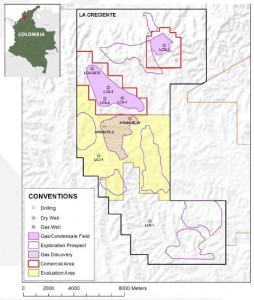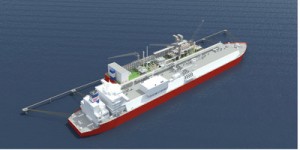On the west coast of British Columbia, onshore LNG terminals and pipelines to feed those terminals have become a media and political hot potato, with environmentalists increasing the instability of these projects which can cost $50-$60 billion. In Colombia, Pacific Rubiales (PRE:TSX) announced this morning that they have executed a heads of agreement for a five year purchase and sale agreement for LNG with the Russian gas giant, Gazprom. The agreement will see roughly 500,000 tons of LNG per year, starting in the second quarter of 2015, get extracted from PRE’s La Creciente Field in northern Colombia and piped to the coastline. As part of the agreement, PRE must procure and develop the world’s first operational floating LNG (FLNG) production and storage unit. The agreement also states PRE must build a LNG floating storage unit with a minimum LNG capacity of 138,000m3.
A FLNG plant is exactly what it sounds like, except they much smaller with much less storage capacity than its onshore cousin. Shell recently approved a $13 billion FLNG plant called the Prelude which will produce 3.6 million tonnes of LNG per year and will be permanently moored 200km off the coast of Australia. These types of facilities are becoming increasingly important in the global energy markets as the costs of onshore LNG plants continue to increase.
To fund these enormous projects, energy giants will lock-in long term supply contracts with Asian buyers. These 20-30 year contracts are typically linked to crude oil prices and as a result the margin for error if the price of oil decreases is minimal. This type of formula is becoming increasingly undesirable for the energy giants. Enter FLNG plants. Although these do not have the capacity of the onshore terminals, they can help increase the leverage for the energy companies.
PRE is already in the process of building an 88km, 18 inch diameter pipeline capable of handling 100MMscf/d of gas and transporting it to the coastline of Colombia. The company already has a 15 year toll agreement with Exmar. The FLNG barge is being built by the Shanghai-based Wilson Group and is currently under construction. The La Creciente Field is one of the largest natural gas fields discovered in Colombia in recent years. It hosts net 2P reserves of 420bcfe and is 100% owned and operated by PRE.
Gazprom is the largest producer of natural gas in the world and in 2011 produced 17% of global natural gas output.
Below is a quick video on PRE's FLNG plant: (Exmar)























